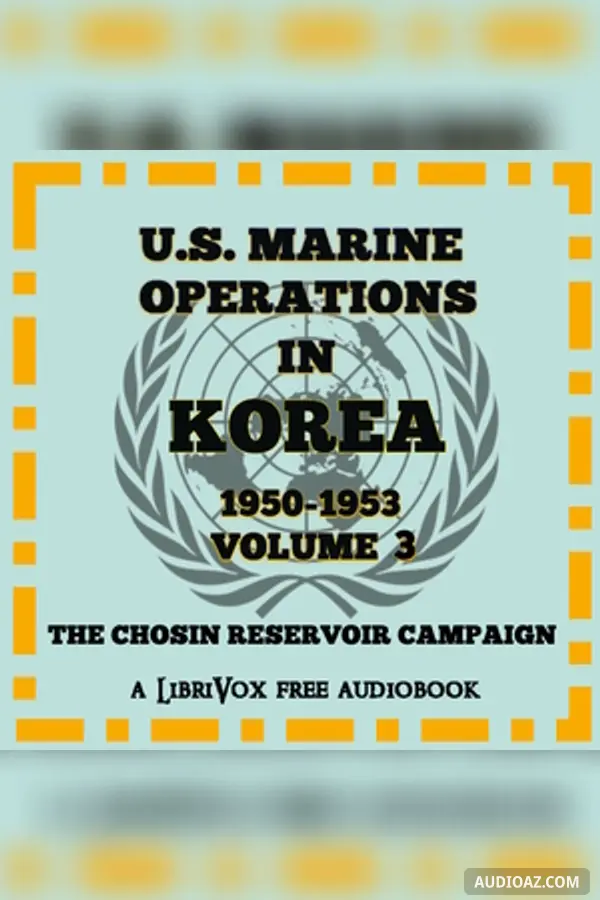
U.S. Marine Operations in Korea, 1950-1953, Volume 3: The Chosin Reservoir Campaign - Free Audiobook
Author(s): Lynn MontrossNicholas Canzona
Language: English
Genre(s): War & Military Fiction
1 / 31Forward and Preface
- 1. Forward and Preface
- 2. Chapter 1, Part 1 - Problems of Victory
- 3. Chapter 1, Part 2 - Problems of Victory
- 4. Chapter 2, Part 1 - The Wonsan Landing
- 5. Chapter 2, Part 2 - The Wonsan Landing
- 6. Chapter 3, Part 1 - First Blood At Kojo
- 7. Chapter 3, Part 2 - First Blood At Kojo
- 8. Chapter 4, Part 1 - Majon-ni and Ambush Alley
- 9. Chapter 4, Part 2 - Majon-ni and Ambush Alley
- 10. Chapter 5, Part 1 - Red China to the Rescue
- 11. Chapter 5, Part 2 - Red China to the Rescue
- 12. Chapter 6, Part 1 - The Battle of Sudong
- 13. Chapter 6, Part 2 - The Battle of Sudong
- 14. Chapter 7, Part 1 - Advance To The Chosin Reservoir
- 15. Chapter 7, Part 2 - Advance To The Chosin Reservoir
- 16. Chapter 8, Part 1 - Crisis at Yudam-ni
- 17. Chapter 8, Part 2 - Crisis at Yudam-ni
- 18. Chapter 9, Part 1 - Fox Hill
- 19. Chapter 9, Part 2 - Fox Hill
- 20. Chapter 10, Part 1 - Hagaru’s Night of Fire
- 21. Chapter 10, Part 2 - Hagaru’s Night of Fire
- 22. Chapter 11, Part 1 - Task Force Drysdale
- 23. Chapter 11, Part 2 - Task Force Drysdale
- 24. Chapter 12, Part 1 - Breakout From Yudam-ni
- 25. Chapter 12, Part 2 - Breakout From Yudam-ni
- 26. Chapter 13, Part 1 - Regroupment at Hagaru
- 27. Chapter 13, Part 2 - Regroupment at Hagaru
- 28. Chapter 14, Part 1 - Onward from Koto-ri
- 29. Chapter 14, Part 2 - Onward from Koto-ri
- 30. Chapter 15, Part 1 - The Hungnam Redeployment
- 31. Chapter 15, Part 2 - The Hungnam Redeployment
About
“Where do we go from here?” would hardly have been an oversimplified summary of the questions confronting UN leaders when it became apparent that the NKPA forces were defeated. As early as 19 July, the dynamic ROK leader had made it plain that he did not propose to accept the pre-invasion status quo. He served notice that his forces would unify Korea by driving to the Manchurian border. Since the Communists had violated the 38th Parallel, the aged Rhee declared, this imaginary demarcation between North and South no longer existed. He pointed out that the sole purpose of the line in the first place had been to divide Soviet and American occupation zones after World War II, in order to facilitate the Japanese surrender and pave the way for a democratic Korean government. Anticipating his authority for crossing the 38th Parallel, CINCUNC on 26 September had directed his Joint Special Plans and Operations Group (JSPOG) to develop a plan for operations north of the border. The ability of the Marines to fight their way through twelve Chinese divisions over a 78-mile mountain road in sub-zero weather cannot be explained by courage and endurance alone. It also owed to the high degree of professional forethought and skill as well as the “uncommon valor” expected of all Marines. - Summary by Montross, Canzona and McC. Pate
Comments
Be the first to comment
There aren't any comments on this content yet. Start the conversation!
Discover More
Tags: U.S. Marine Operations in Korea, 1950-1953, Volume 3: The Chosin Reservoir Campaign audio, U.S. Marine Operations in Korea, 1950-1953, Volume 3: The Chosin Reservoir Campaign - Lynn Montross, Nicholas Canzona audio, War & Military Fiction audio, free audiobook, free audio book, audioaz






